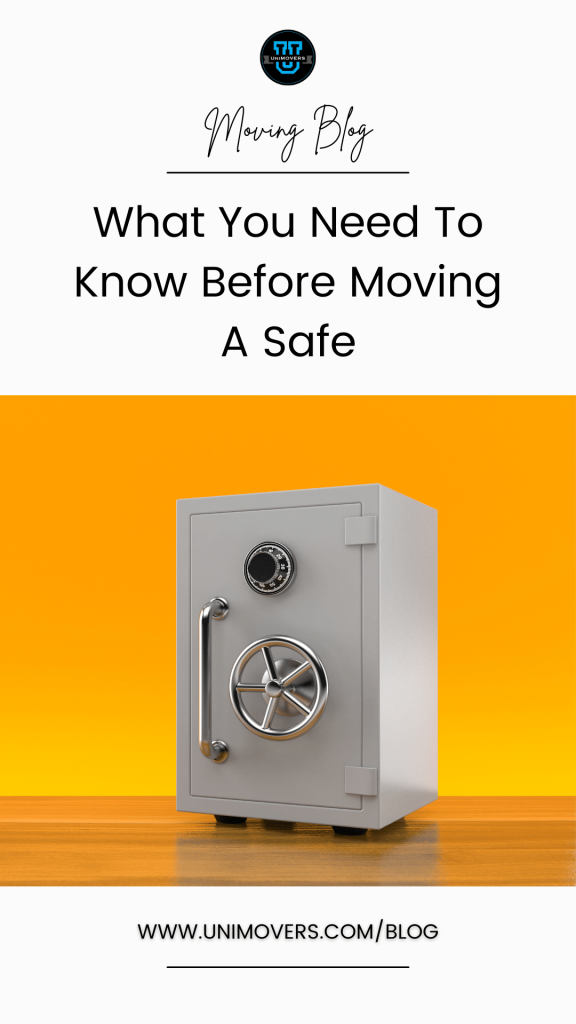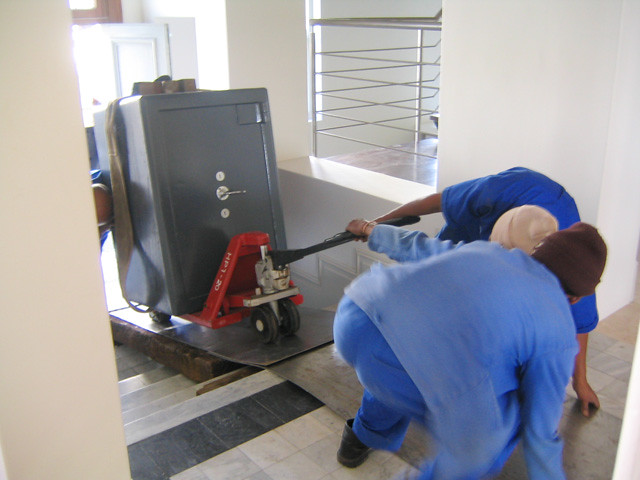Owning a safe is a great way to keep your valuable possessions, well, safe. Safes are designed to be hard to carry away or break into. Unfortunately, these safety features also make safes difficult to move. Here’s the lowdown on moving a safe, including how to assess a safe, how to prepare to move a safe, how to move a safe, and how to move a heavy safe.
Table of Contents

Assessing a Safe Before a Move
First you should consider what kind of safe you’re dealing with. Safes can vary widely in weight due to differences in their material and capacity. Small safes can be light, perhaps around 25 pounds. Medium sized safes are often fireproof and therefore have thicker walls; they might be around 200 pounds. Meanwhile, industrial safes might have multiple layered walls and be several hundred pounds or heavier.
Don’t forget that you can remove items from the safe to reduce its weight. Sometimes you can also remove the door of the safe or otherwise disassemble it. If possible, taking these steps can make your job easier.
With a small safe, you can consider moving it yourself. If your safe is around 50 pounds or heavier, you want helpers involved in moving it. For 100 pounds or more, you probably won’t be able to move it without specialized equipment. If it’s upwards of 500 pounds, you certainly want to consider getting professional help in moving it.
Lastly, if you need to move the safe through doorways or narrow stairwells, measure the safe in advance to make sure that it will fit. You don’t want to get stuck on moving day!
Preparing To Move a Heavy Safe
Say your safe is too heavy to lift easily but light enough that you want to move it yourself. You should have at least two other people who can assist you. Having proper equipment is the best way to make your job manageable. You will want to figure out how to use a dolly, ratchet straps, wooden planks, and moving blankets. Make sure that items like the dolly and the planks will be able to withstand the weight of your safe.
You will also want to prepare yourself by wearing work gloves that will give you a good grip on the safe, as well as close-toed shoes that won’t slip around.
You may choose to do some basic stretches right before the move to help avoid injuries. Additionally, plan out the move with your helpers. Everyone should know the moving route and have a good idea of they’ll be doing throughout the process.
As you move the safe try to keep it upright. Some safes may no longer work after being turned on their sides. In addition, if you start to drop the safe, don’t try to catch it. Always stay above the safe to protect yourself in case it falls.
Lastly, you may also want to consider how you will protect structures like painted walls, wooden floors, or banisters that could be damaged by scrapes. For instance, you can tape a layer of blankets around banisters to keep them safe.
How To Move a Heavy Safe
First, prepare your safe by removing as much weight from it as possible. Then, wrap the moving blanket around the safe to protect it throughout the move. Next, secure the safe on the dolly with ratchet straps and start the move.
As you lift the safe, take care to keep your back straight and lift with your legs. Lift slowly so that you can ensure you’re in control. Check in frequently with your helpers to make sure that nobody is in danger of injuring themselves or dropping the safe.
How To Transport a Heavy Safe Up and Down Stairs
If you encounter stairs, you might want to use wooden planks as ramps so that you can slide the safe up and down, like in the picture below. If there are many stairs, have one person guide the safe while the others lift it up or down one step at a time. You may also want to use a stair-climbing dolly to make the process easier. If you go this route, your team can help keep the safe steady.

Moving a Safe Yourself Versus Getting Help
If you’re feeling overwhelmed at the thought of moving a safe or other heavy furniture, you can always get help. There are a few options to find help for moving your safe.
One you may wish to consider is labor-only movers. These movers are ideal for moving just one item like a safe. If you provide the equipment and transportation, they’ll provide the muscle. Hiring a labor-only moving service can save you up to 30-50% what you would pay for a full service moving company.
Conclusion
Now you have an idea of how to move a safe, as well as whether or not you should hire a moving service to help you. Good luck with your move!

Sophie Pollack-Milgate has a day job as a bioethics research assistant. In her free time, she likes to read books critiquing psychiatry, complain about how either ice or heat are ruining her runs (depending on the season), and modify recipes beyond recognition.




